Hilton Hotel: A Case Study on Marketing Strategies for the Tru Brand
VerifiedAdded on 2023/04/22
|23
|5361
|354
Case Study
AI Summary
This case study analyzes Hilton Hotel's strategies for launching its new brand, Tru, aimed at the midscale market. It evaluates Hilton's current positioning, marketing efforts, and the potential of the Tru brand. The study explores the challenges and opportunities Hilton faces in targeting a new customer segment while maintaining its brand image. It also assesses the impact of marketing and functional strategies undertaken to successfully launch Tru, considering feedback from property owners, stakeholders, and customers. The research aims to provide recommendations to help Hilton overcome identified gaps and optimize its approach to the midscale market. Desklib provides a platform for students to access similar solved assignments and study resources.
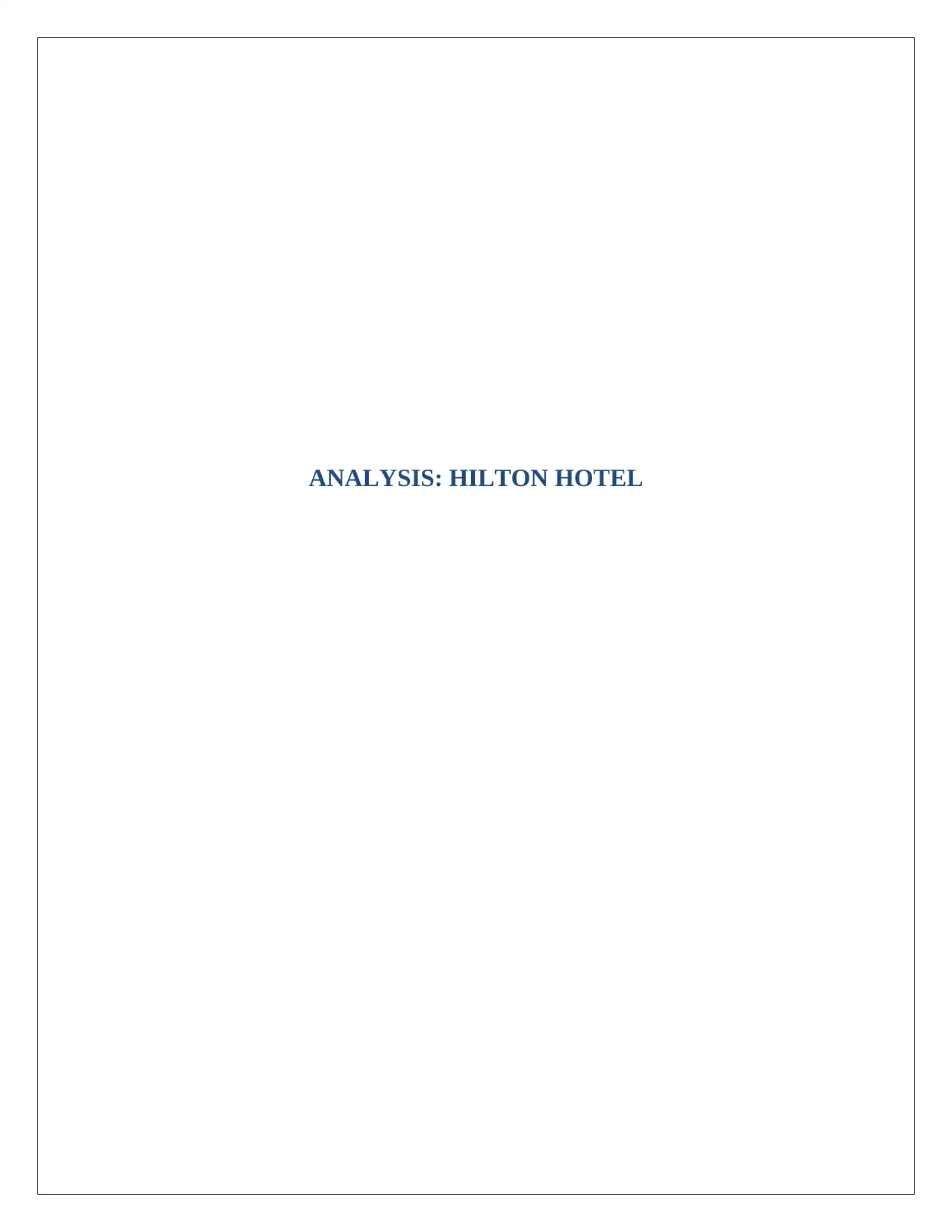
ANALYSIS: HILTON HOTEL
Paraphrase This Document
Need a fresh take? Get an instant paraphrase of this document with our AI Paraphraser
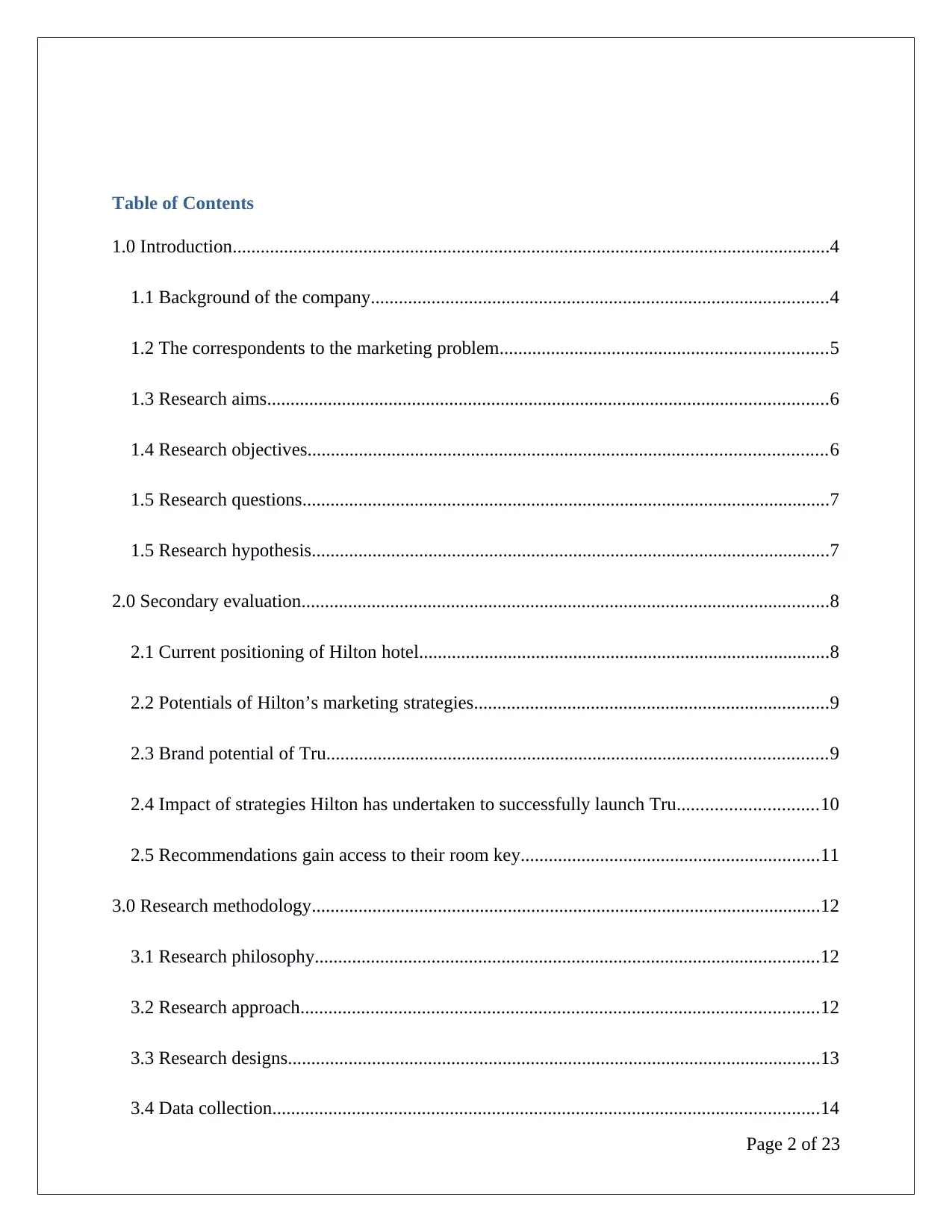
Table of Contents
1.0 Introduction................................................................................................................................4
1.1 Background of the company..................................................................................................4
1.2 The correspondents to the marketing problem......................................................................5
1.3 Research aims........................................................................................................................6
1.4 Research objectives...............................................................................................................6
1.5 Research questions.................................................................................................................7
1.5 Research hypothesis...............................................................................................................7
2.0 Secondary evaluation.................................................................................................................8
2.1 Current positioning of Hilton hotel........................................................................................8
2.2 Potentials of Hilton’s marketing strategies............................................................................9
2.3 Brand potential of Tru...........................................................................................................9
2.4 Impact of strategies Hilton has undertaken to successfully launch Tru..............................10
2.5 Recommendations gain access to their room key................................................................11
3.0 Research methodology.............................................................................................................12
3.1 Research philosophy............................................................................................................12
3.2 Research approach...............................................................................................................12
3.3 Research designs..................................................................................................................13
3.4 Data collection.....................................................................................................................14
Page 2 of 23
1.0 Introduction................................................................................................................................4
1.1 Background of the company..................................................................................................4
1.2 The correspondents to the marketing problem......................................................................5
1.3 Research aims........................................................................................................................6
1.4 Research objectives...............................................................................................................6
1.5 Research questions.................................................................................................................7
1.5 Research hypothesis...............................................................................................................7
2.0 Secondary evaluation.................................................................................................................8
2.1 Current positioning of Hilton hotel........................................................................................8
2.2 Potentials of Hilton’s marketing strategies............................................................................9
2.3 Brand potential of Tru...........................................................................................................9
2.4 Impact of strategies Hilton has undertaken to successfully launch Tru..............................10
2.5 Recommendations gain access to their room key................................................................11
3.0 Research methodology.............................................................................................................12
3.1 Research philosophy............................................................................................................12
3.2 Research approach...............................................................................................................12
3.3 Research designs..................................................................................................................13
3.4 Data collection.....................................................................................................................14
Page 2 of 23
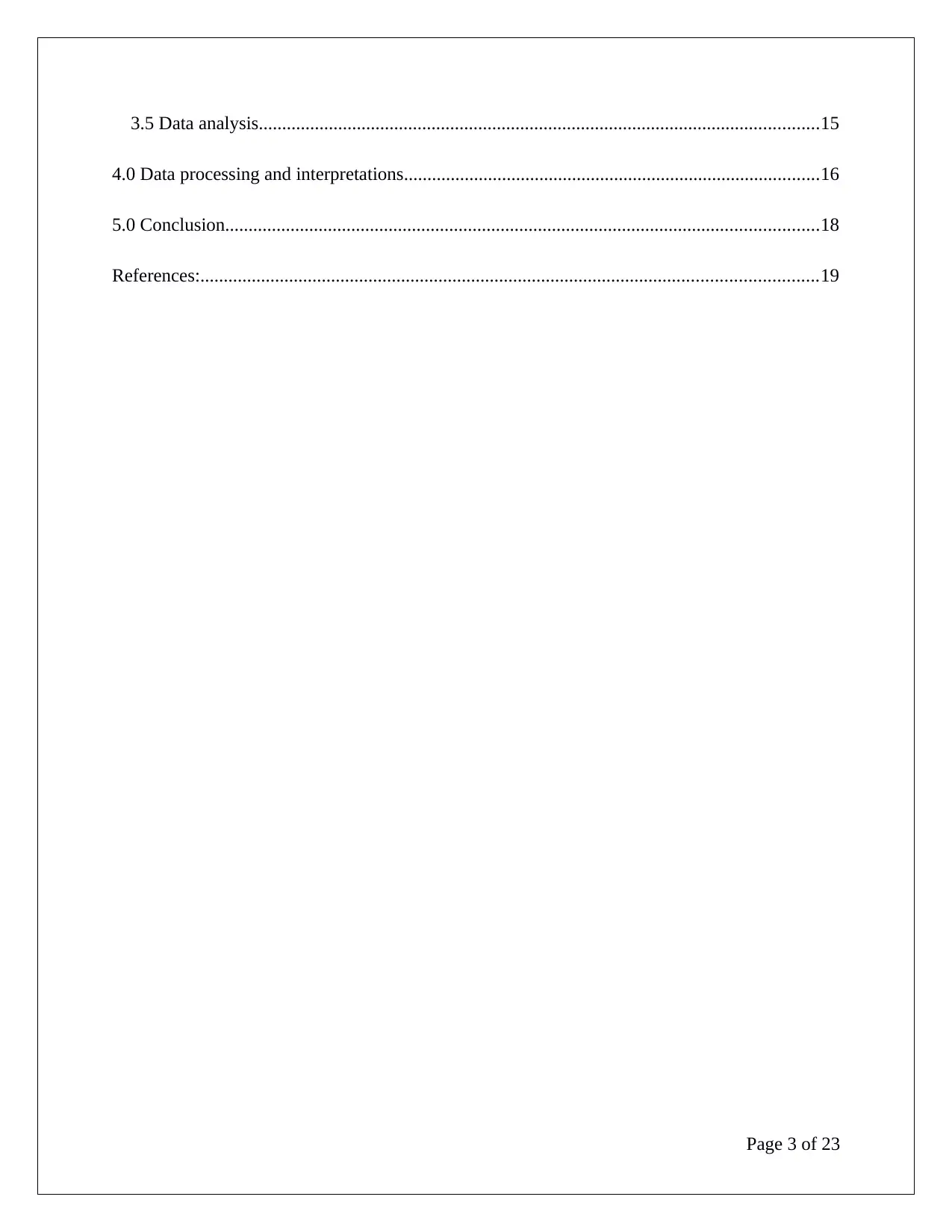
3.5 Data analysis........................................................................................................................15
4.0 Data processing and interpretations.........................................................................................16
5.0 Conclusion...............................................................................................................................18
References:....................................................................................................................................19
Page 3 of 23
4.0 Data processing and interpretations.........................................................................................16
5.0 Conclusion...............................................................................................................................18
References:....................................................................................................................................19
Page 3 of 23
⊘ This is a preview!⊘
Do you want full access?
Subscribe today to unlock all pages.

Trusted by 1+ million students worldwide

1.0 Introduction
The hotel industry has been identified as the most booming sector in the global context. Different
multinational brands operating in a similar sector are bringing with them several effective
marketing lines in innovation front to maintain their leading stand in the economy (Bahn, 2012).
In a similar manner, Hilton Group is also recognized as the leading hotel brand in the
international market for its successful set of branches in different nations and franchise
operations (Bakhshi, 2012). The present study attempts to evaluate the current positioning of
Hilton Hotels, the marketing efforts it has taken and their potential in the target market. It would
also underscore the marketing and service designing approach the company is aiming to conduct
for launching its new brand Tru in Maldives or Bali to fit the expectations of midscale segments.
1.1 Background of the company
Hilton Hotels Corporation is the American multinational company operating in the hospitality
sector. The brand tends to manage and franchise a wider portfolio of resorts and hotels in the
global context. The organization was established in the year 1919 and headquartered in Virginia
(Hilton.com. 2019). The information gathered from the provided case study underscores that by
2015, the management of the hotel acquired a market share of 11% and 4610 properties
consisting more than millions of rooms in total 100 nations and territories. It had also been
estimated from the data highlighted in the similar source that Hilton’s operating cash flow
consisted 34% from leased or owned properties, 13% from the managed properties, 11% from
timeshares and 42% from the franchised properties.
It has been identified that the franchise agreements like managing hotel operations and regular
functions are no longer administered by Hilton but by the property owners. It has also been
Page 4 of 23
The hotel industry has been identified as the most booming sector in the global context. Different
multinational brands operating in a similar sector are bringing with them several effective
marketing lines in innovation front to maintain their leading stand in the economy (Bahn, 2012).
In a similar manner, Hilton Group is also recognized as the leading hotel brand in the
international market for its successful set of branches in different nations and franchise
operations (Bakhshi, 2012). The present study attempts to evaluate the current positioning of
Hilton Hotels, the marketing efforts it has taken and their potential in the target market. It would
also underscore the marketing and service designing approach the company is aiming to conduct
for launching its new brand Tru in Maldives or Bali to fit the expectations of midscale segments.
1.1 Background of the company
Hilton Hotels Corporation is the American multinational company operating in the hospitality
sector. The brand tends to manage and franchise a wider portfolio of resorts and hotels in the
global context. The organization was established in the year 1919 and headquartered in Virginia
(Hilton.com. 2019). The information gathered from the provided case study underscores that by
2015, the management of the hotel acquired a market share of 11% and 4610 properties
consisting more than millions of rooms in total 100 nations and territories. It had also been
estimated from the data highlighted in the similar source that Hilton’s operating cash flow
consisted 34% from leased or owned properties, 13% from the managed properties, 11% from
timeshares and 42% from the franchised properties.
It has been identified that the franchise agreements like managing hotel operations and regular
functions are no longer administered by Hilton but by the property owners. It has also been
Page 4 of 23
Paraphrase This Document
Need a fresh take? Get an instant paraphrase of this document with our AI Paraphraser
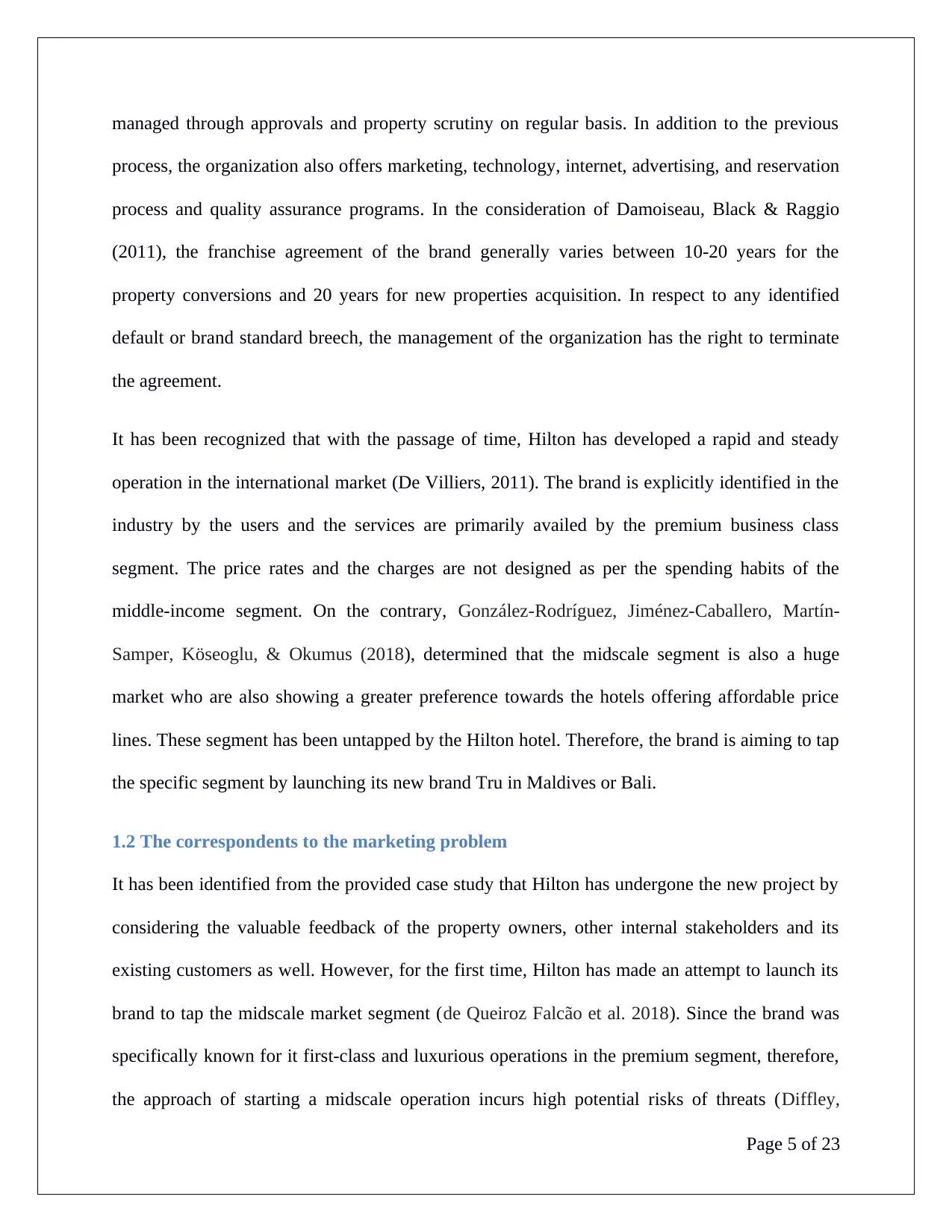
managed through approvals and property scrutiny on regular basis. In addition to the previous
process, the organization also offers marketing, technology, internet, advertising, and reservation
process and quality assurance programs. In the consideration of Damoiseau, Black & Raggio
(2011), the franchise agreement of the brand generally varies between 10-20 years for the
property conversions and 20 years for new properties acquisition. In respect to any identified
default or brand standard breech, the management of the organization has the right to terminate
the agreement.
It has been recognized that with the passage of time, Hilton has developed a rapid and steady
operation in the international market (De Villiers, 2011). The brand is explicitly identified in the
industry by the users and the services are primarily availed by the premium business class
segment. The price rates and the charges are not designed as per the spending habits of the
middle-income segment. On the contrary, González-Rodríguez, Jiménez-Caballero, Martín-
Samper, Köseoglu, & Okumus (2018), determined that the midscale segment is also a huge
market who are also showing a greater preference towards the hotels offering affordable price
lines. These segment has been untapped by the Hilton hotel. Therefore, the brand is aiming to tap
the specific segment by launching its new brand Tru in Maldives or Bali.
1.2 The correspondents to the marketing problem
It has been identified from the provided case study that Hilton has undergone the new project by
considering the valuable feedback of the property owners, other internal stakeholders and its
existing customers as well. However, for the first time, Hilton has made an attempt to launch its
brand to tap the midscale market segment (de Queiroz Falcão et al. 2018). Since the brand was
specifically known for it first-class and luxurious operations in the premium segment, therefore,
the approach of starting a midscale operation incurs high potential risks of threats (Diffley,
Page 5 of 23
process, the organization also offers marketing, technology, internet, advertising, and reservation
process and quality assurance programs. In the consideration of Damoiseau, Black & Raggio
(2011), the franchise agreement of the brand generally varies between 10-20 years for the
property conversions and 20 years for new properties acquisition. In respect to any identified
default or brand standard breech, the management of the organization has the right to terminate
the agreement.
It has been recognized that with the passage of time, Hilton has developed a rapid and steady
operation in the international market (De Villiers, 2011). The brand is explicitly identified in the
industry by the users and the services are primarily availed by the premium business class
segment. The price rates and the charges are not designed as per the spending habits of the
middle-income segment. On the contrary, González-Rodríguez, Jiménez-Caballero, Martín-
Samper, Köseoglu, & Okumus (2018), determined that the midscale segment is also a huge
market who are also showing a greater preference towards the hotels offering affordable price
lines. These segment has been untapped by the Hilton hotel. Therefore, the brand is aiming to tap
the specific segment by launching its new brand Tru in Maldives or Bali.
1.2 The correspondents to the marketing problem
It has been identified from the provided case study that Hilton has undergone the new project by
considering the valuable feedback of the property owners, other internal stakeholders and its
existing customers as well. However, for the first time, Hilton has made an attempt to launch its
brand to tap the midscale market segment (de Queiroz Falcão et al. 2018). Since the brand was
specifically known for it first-class and luxurious operations in the premium segment, therefore,
the approach of starting a midscale operation incurs high potential risks of threats (Diffley,
Page 5 of 23
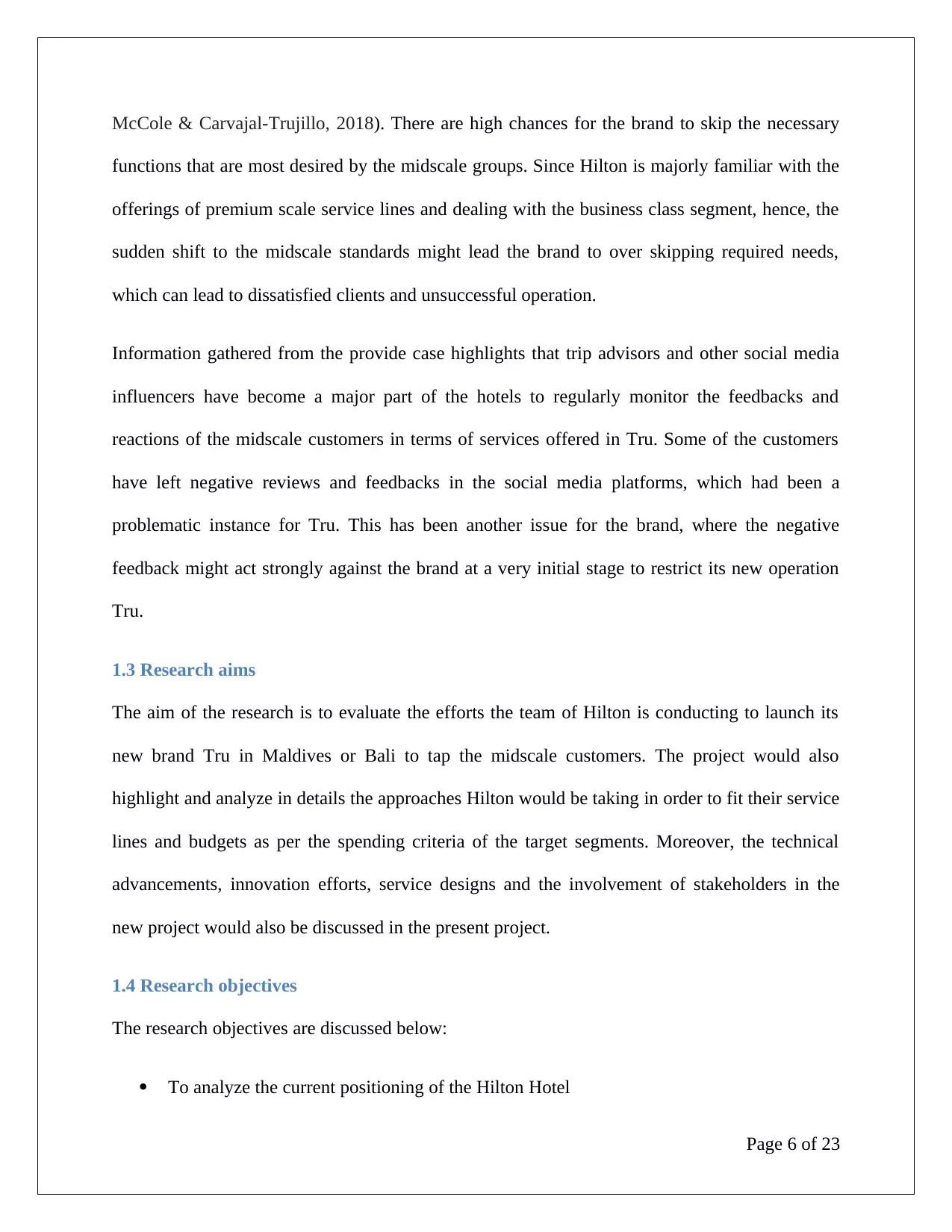
McCole & Carvajal-Trujillo, 2018). There are high chances for the brand to skip the necessary
functions that are most desired by the midscale groups. Since Hilton is majorly familiar with the
offerings of premium scale service lines and dealing with the business class segment, hence, the
sudden shift to the midscale standards might lead the brand to over skipping required needs,
which can lead to dissatisfied clients and unsuccessful operation.
Information gathered from the provide case highlights that trip advisors and other social media
influencers have become a major part of the hotels to regularly monitor the feedbacks and
reactions of the midscale customers in terms of services offered in Tru. Some of the customers
have left negative reviews and feedbacks in the social media platforms, which had been a
problematic instance for Tru. This has been another issue for the brand, where the negative
feedback might act strongly against the brand at a very initial stage to restrict its new operation
Tru.
1.3 Research aims
The aim of the research is to evaluate the efforts the team of Hilton is conducting to launch its
new brand Tru in Maldives or Bali to tap the midscale customers. The project would also
highlight and analyze in details the approaches Hilton would be taking in order to fit their service
lines and budgets as per the spending criteria of the target segments. Moreover, the technical
advancements, innovation efforts, service designs and the involvement of stakeholders in the
new project would also be discussed in the present project.
1.4 Research objectives
The research objectives are discussed below:
To analyze the current positioning of the Hilton Hotel
Page 6 of 23
functions that are most desired by the midscale groups. Since Hilton is majorly familiar with the
offerings of premium scale service lines and dealing with the business class segment, hence, the
sudden shift to the midscale standards might lead the brand to over skipping required needs,
which can lead to dissatisfied clients and unsuccessful operation.
Information gathered from the provide case highlights that trip advisors and other social media
influencers have become a major part of the hotels to regularly monitor the feedbacks and
reactions of the midscale customers in terms of services offered in Tru. Some of the customers
have left negative reviews and feedbacks in the social media platforms, which had been a
problematic instance for Tru. This has been another issue for the brand, where the negative
feedback might act strongly against the brand at a very initial stage to restrict its new operation
Tru.
1.3 Research aims
The aim of the research is to evaluate the efforts the team of Hilton is conducting to launch its
new brand Tru in Maldives or Bali to tap the midscale customers. The project would also
highlight and analyze in details the approaches Hilton would be taking in order to fit their service
lines and budgets as per the spending criteria of the target segments. Moreover, the technical
advancements, innovation efforts, service designs and the involvement of stakeholders in the
new project would also be discussed in the present project.
1.4 Research objectives
The research objectives are discussed below:
To analyze the current positioning of the Hilton Hotel
Page 6 of 23
⊘ This is a preview!⊘
Do you want full access?
Subscribe today to unlock all pages.

Trusted by 1+ million students worldwide
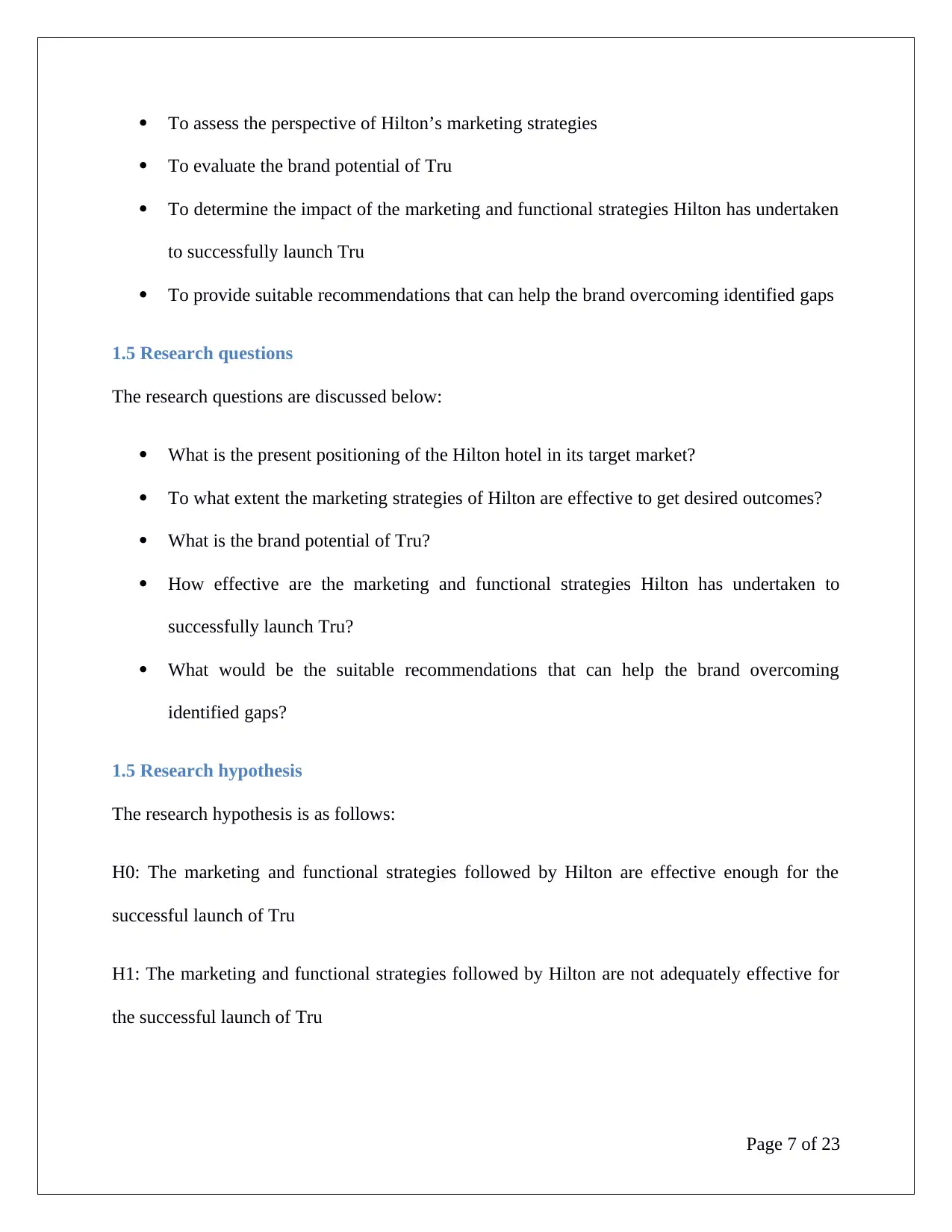
To assess the perspective of Hilton’s marketing strategies
To evaluate the brand potential of Tru
To determine the impact of the marketing and functional strategies Hilton has undertaken
to successfully launch Tru
To provide suitable recommendations that can help the brand overcoming identified gaps
1.5 Research questions
The research questions are discussed below:
What is the present positioning of the Hilton hotel in its target market?
To what extent the marketing strategies of Hilton are effective to get desired outcomes?
What is the brand potential of Tru?
How effective are the marketing and functional strategies Hilton has undertaken to
successfully launch Tru?
What would be the suitable recommendations that can help the brand overcoming
identified gaps?
1.5 Research hypothesis
The research hypothesis is as follows:
H0: The marketing and functional strategies followed by Hilton are effective enough for the
successful launch of Tru
H1: The marketing and functional strategies followed by Hilton are not adequately effective for
the successful launch of Tru
Page 7 of 23
To evaluate the brand potential of Tru
To determine the impact of the marketing and functional strategies Hilton has undertaken
to successfully launch Tru
To provide suitable recommendations that can help the brand overcoming identified gaps
1.5 Research questions
The research questions are discussed below:
What is the present positioning of the Hilton hotel in its target market?
To what extent the marketing strategies of Hilton are effective to get desired outcomes?
What is the brand potential of Tru?
How effective are the marketing and functional strategies Hilton has undertaken to
successfully launch Tru?
What would be the suitable recommendations that can help the brand overcoming
identified gaps?
1.5 Research hypothesis
The research hypothesis is as follows:
H0: The marketing and functional strategies followed by Hilton are effective enough for the
successful launch of Tru
H1: The marketing and functional strategies followed by Hilton are not adequately effective for
the successful launch of Tru
Page 7 of 23
Paraphrase This Document
Need a fresh take? Get an instant paraphrase of this document with our AI Paraphraser
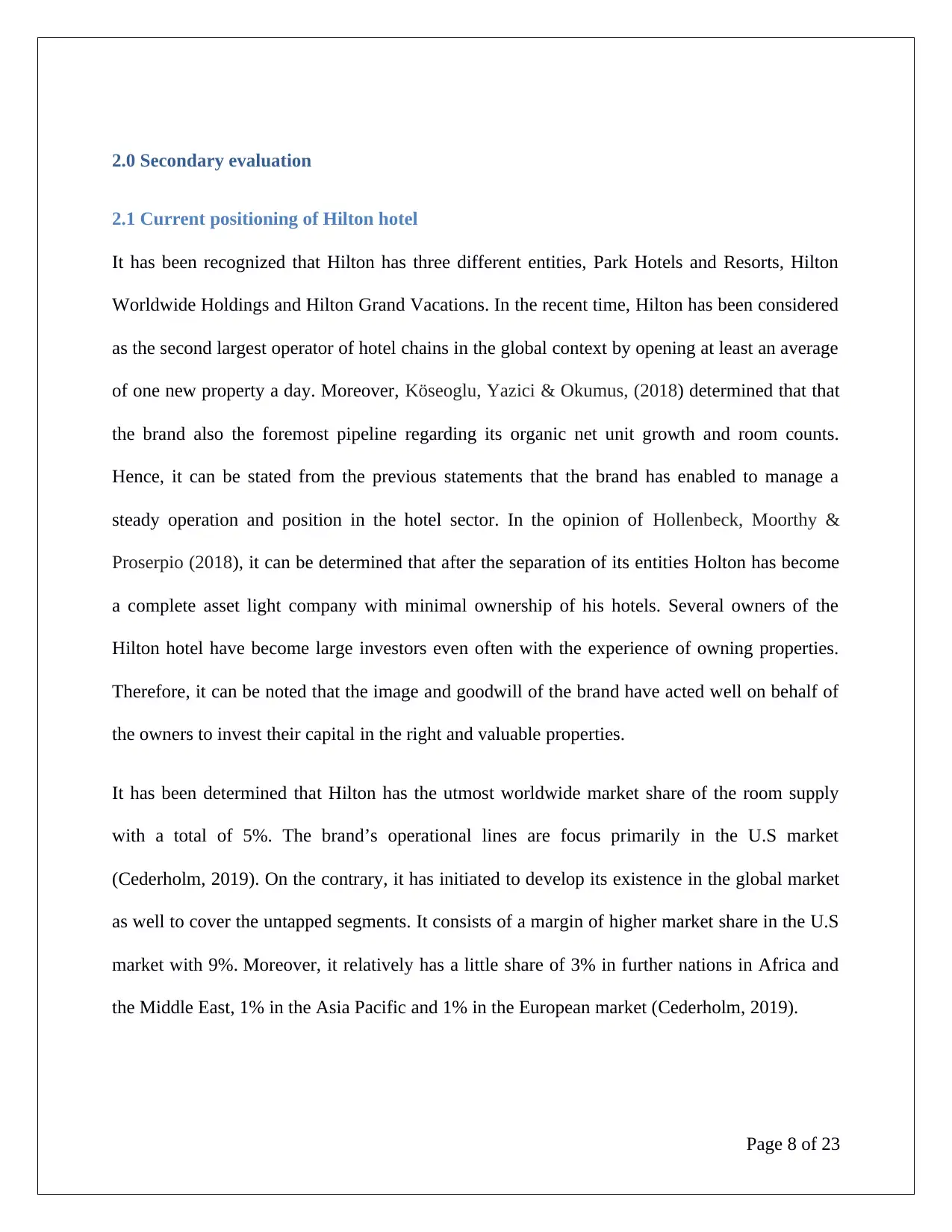
2.0 Secondary evaluation
2.1 Current positioning of Hilton hotel
It has been recognized that Hilton has three different entities, Park Hotels and Resorts, Hilton
Worldwide Holdings and Hilton Grand Vacations. In the recent time, Hilton has been considered
as the second largest operator of hotel chains in the global context by opening at least an average
of one new property a day. Moreover, Köseoglu, Yazici & Okumus, (2018) determined that that
the brand also the foremost pipeline regarding its organic net unit growth and room counts.
Hence, it can be stated from the previous statements that the brand has enabled to manage a
steady operation and position in the hotel sector. In the opinion of Hollenbeck, Moorthy &
Proserpio (2018), it can be determined that after the separation of its entities Holton has become
a complete asset light company with minimal ownership of his hotels. Several owners of the
Hilton hotel have become large investors even often with the experience of owning properties.
Therefore, it can be noted that the image and goodwill of the brand have acted well on behalf of
the owners to invest their capital in the right and valuable properties.
It has been determined that Hilton has the utmost worldwide market share of the room supply
with a total of 5%. The brand’s operational lines are focus primarily in the U.S market
(Cederholm, 2019). On the contrary, it has initiated to develop its existence in the global market
as well to cover the untapped segments. It consists of a margin of higher market share in the U.S
market with 9%. Moreover, it relatively has a little share of 3% in further nations in Africa and
the Middle East, 1% in the Asia Pacific and 1% in the European market (Cederholm, 2019).
Page 8 of 23
2.1 Current positioning of Hilton hotel
It has been recognized that Hilton has three different entities, Park Hotels and Resorts, Hilton
Worldwide Holdings and Hilton Grand Vacations. In the recent time, Hilton has been considered
as the second largest operator of hotel chains in the global context by opening at least an average
of one new property a day. Moreover, Köseoglu, Yazici & Okumus, (2018) determined that that
the brand also the foremost pipeline regarding its organic net unit growth and room counts.
Hence, it can be stated from the previous statements that the brand has enabled to manage a
steady operation and position in the hotel sector. In the opinion of Hollenbeck, Moorthy &
Proserpio (2018), it can be determined that after the separation of its entities Holton has become
a complete asset light company with minimal ownership of his hotels. Several owners of the
Hilton hotel have become large investors even often with the experience of owning properties.
Therefore, it can be noted that the image and goodwill of the brand have acted well on behalf of
the owners to invest their capital in the right and valuable properties.
It has been determined that Hilton has the utmost worldwide market share of the room supply
with a total of 5%. The brand’s operational lines are focus primarily in the U.S market
(Cederholm, 2019). On the contrary, it has initiated to develop its existence in the global market
as well to cover the untapped segments. It consists of a margin of higher market share in the U.S
market with 9%. Moreover, it relatively has a little share of 3% in further nations in Africa and
the Middle East, 1% in the Asia Pacific and 1% in the European market (Cederholm, 2019).
Page 8 of 23
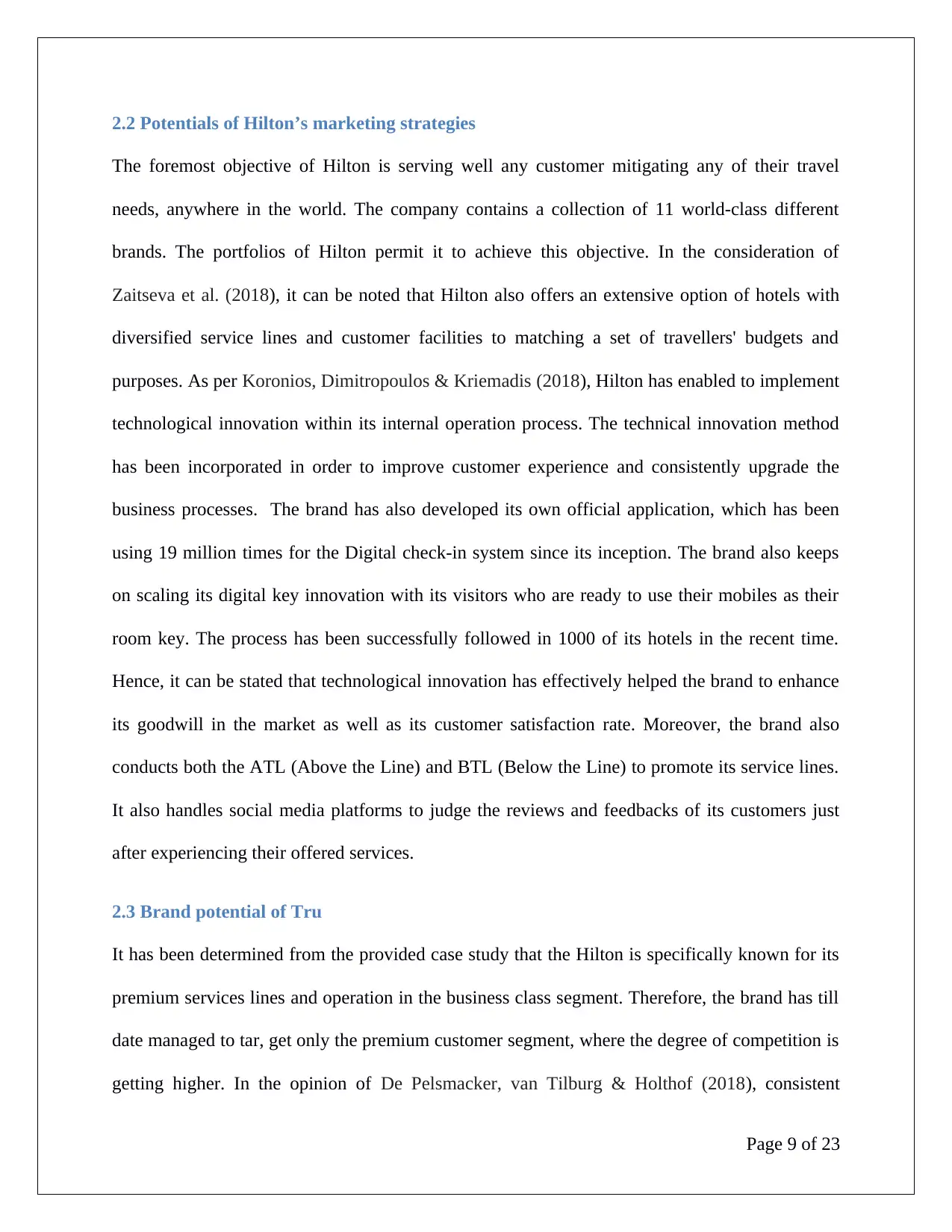
2.2 Potentials of Hilton’s marketing strategies
The foremost objective of Hilton is serving well any customer mitigating any of their travel
needs, anywhere in the world. The company contains a collection of 11 world-class different
brands. The portfolios of Hilton permit it to achieve this objective. In the consideration of
Zaitseva et al. (2018), it can be noted that Hilton also offers an extensive option of hotels with
diversified service lines and customer facilities to matching a set of travellers' budgets and
purposes. As per Koronios, Dimitropoulos & Kriemadis (2018), Hilton has enabled to implement
technological innovation within its internal operation process. The technical innovation method
has been incorporated in order to improve customer experience and consistently upgrade the
business processes. The brand has also developed its own official application, which has been
using 19 million times for the Digital check-in system since its inception. The brand also keeps
on scaling its digital key innovation with its visitors who are ready to use their mobiles as their
room key. The process has been successfully followed in 1000 of its hotels in the recent time.
Hence, it can be stated that technological innovation has effectively helped the brand to enhance
its goodwill in the market as well as its customer satisfaction rate. Moreover, the brand also
conducts both the ATL (Above the Line) and BTL (Below the Line) to promote its service lines.
It also handles social media platforms to judge the reviews and feedbacks of its customers just
after experiencing their offered services.
2.3 Brand potential of Tru
It has been determined from the provided case study that the Hilton is specifically known for its
premium services lines and operation in the business class segment. Therefore, the brand has till
date managed to tar, get only the premium customer segment, where the degree of competition is
getting higher. In the opinion of De Pelsmacker, van Tilburg & Holthof (2018), consistent
Page 9 of 23
The foremost objective of Hilton is serving well any customer mitigating any of their travel
needs, anywhere in the world. The company contains a collection of 11 world-class different
brands. The portfolios of Hilton permit it to achieve this objective. In the consideration of
Zaitseva et al. (2018), it can be noted that Hilton also offers an extensive option of hotels with
diversified service lines and customer facilities to matching a set of travellers' budgets and
purposes. As per Koronios, Dimitropoulos & Kriemadis (2018), Hilton has enabled to implement
technological innovation within its internal operation process. The technical innovation method
has been incorporated in order to improve customer experience and consistently upgrade the
business processes. The brand has also developed its own official application, which has been
using 19 million times for the Digital check-in system since its inception. The brand also keeps
on scaling its digital key innovation with its visitors who are ready to use their mobiles as their
room key. The process has been successfully followed in 1000 of its hotels in the recent time.
Hence, it can be stated that technological innovation has effectively helped the brand to enhance
its goodwill in the market as well as its customer satisfaction rate. Moreover, the brand also
conducts both the ATL (Above the Line) and BTL (Below the Line) to promote its service lines.
It also handles social media platforms to judge the reviews and feedbacks of its customers just
after experiencing their offered services.
2.3 Brand potential of Tru
It has been determined from the provided case study that the Hilton is specifically known for its
premium services lines and operation in the business class segment. Therefore, the brand has till
date managed to tar, get only the premium customer segment, where the degree of competition is
getting higher. In the opinion of De Pelsmacker, van Tilburg & Holthof (2018), consistent
Page 9 of 23
⊘ This is a preview!⊘
Do you want full access?
Subscribe today to unlock all pages.

Trusted by 1+ million students worldwide
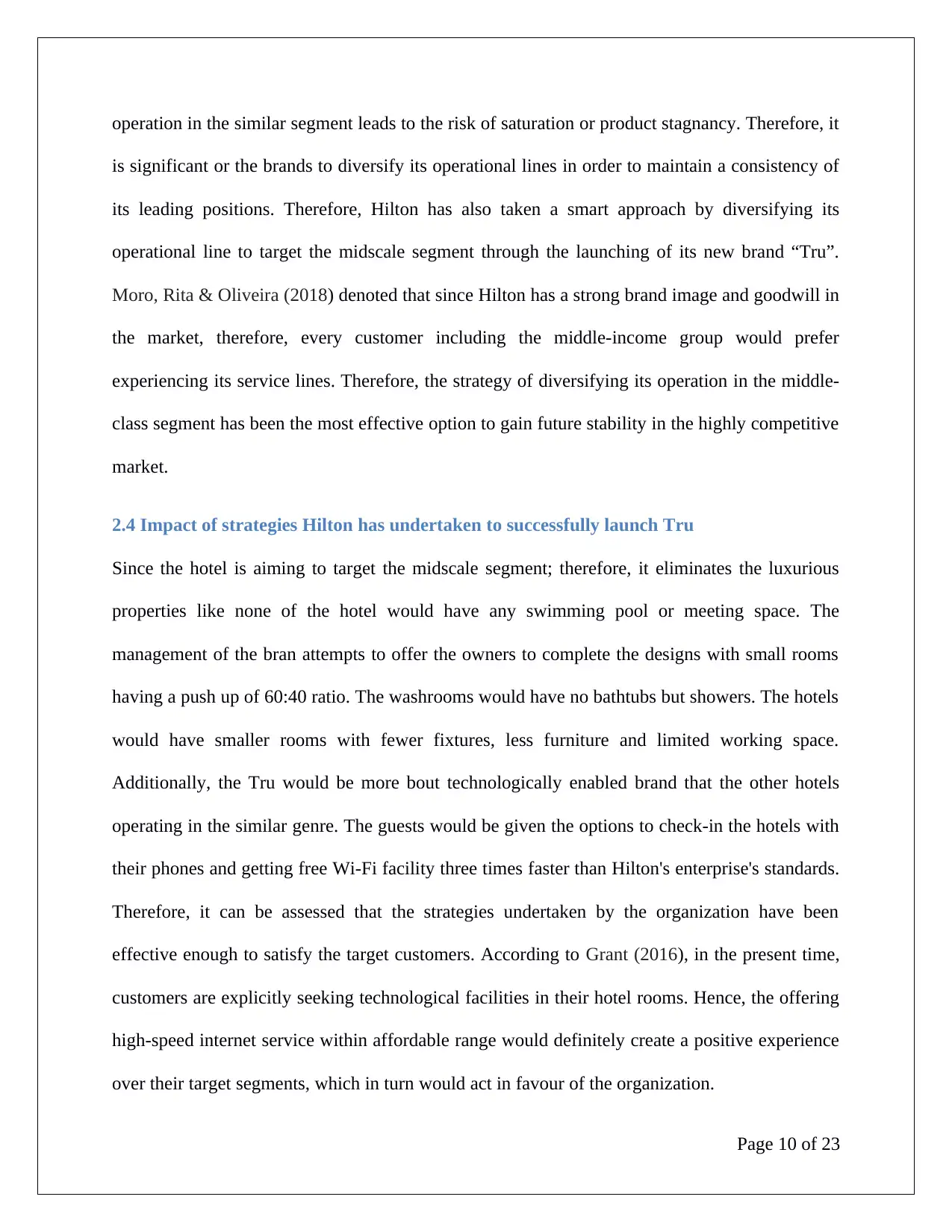
operation in the similar segment leads to the risk of saturation or product stagnancy. Therefore, it
is significant or the brands to diversify its operational lines in order to maintain a consistency of
its leading positions. Therefore, Hilton has also taken a smart approach by diversifying its
operational line to target the midscale segment through the launching of its new brand “Tru”.
Moro, Rita & Oliveira (2018) denoted that since Hilton has a strong brand image and goodwill in
the market, therefore, every customer including the middle-income group would prefer
experiencing its service lines. Therefore, the strategy of diversifying its operation in the middle-
class segment has been the most effective option to gain future stability in the highly competitive
market.
2.4 Impact of strategies Hilton has undertaken to successfully launch Tru
Since the hotel is aiming to target the midscale segment; therefore, it eliminates the luxurious
properties like none of the hotel would have any swimming pool or meeting space. The
management of the bran attempts to offer the owners to complete the designs with small rooms
having a push up of 60:40 ratio. The washrooms would have no bathtubs but showers. The hotels
would have smaller rooms with fewer fixtures, less furniture and limited working space.
Additionally, the Tru would be more bout technologically enabled brand that the other hotels
operating in the similar genre. The guests would be given the options to check-in the hotels with
their phones and getting free Wi-Fi facility three times faster than Hilton's enterprise's standards.
Therefore, it can be assessed that the strategies undertaken by the organization have been
effective enough to satisfy the target customers. According to Grant (2016), in the present time,
customers are explicitly seeking technological facilities in their hotel rooms. Hence, the offering
high-speed internet service within affordable range would definitely create a positive experience
over their target segments, which in turn would act in favour of the organization.
Page 10 of 23
is significant or the brands to diversify its operational lines in order to maintain a consistency of
its leading positions. Therefore, Hilton has also taken a smart approach by diversifying its
operational line to target the midscale segment through the launching of its new brand “Tru”.
Moro, Rita & Oliveira (2018) denoted that since Hilton has a strong brand image and goodwill in
the market, therefore, every customer including the middle-income group would prefer
experiencing its service lines. Therefore, the strategy of diversifying its operation in the middle-
class segment has been the most effective option to gain future stability in the highly competitive
market.
2.4 Impact of strategies Hilton has undertaken to successfully launch Tru
Since the hotel is aiming to target the midscale segment; therefore, it eliminates the luxurious
properties like none of the hotel would have any swimming pool or meeting space. The
management of the bran attempts to offer the owners to complete the designs with small rooms
having a push up of 60:40 ratio. The washrooms would have no bathtubs but showers. The hotels
would have smaller rooms with fewer fixtures, less furniture and limited working space.
Additionally, the Tru would be more bout technologically enabled brand that the other hotels
operating in the similar genre. The guests would be given the options to check-in the hotels with
their phones and getting free Wi-Fi facility three times faster than Hilton's enterprise's standards.
Therefore, it can be assessed that the strategies undertaken by the organization have been
effective enough to satisfy the target customers. According to Grant (2016), in the present time,
customers are explicitly seeking technological facilities in their hotel rooms. Hence, the offering
high-speed internet service within affordable range would definitely create a positive experience
over their target segments, which in turn would act in favour of the organization.
Page 10 of 23
Paraphrase This Document
Need a fresh take? Get an instant paraphrase of this document with our AI Paraphraser
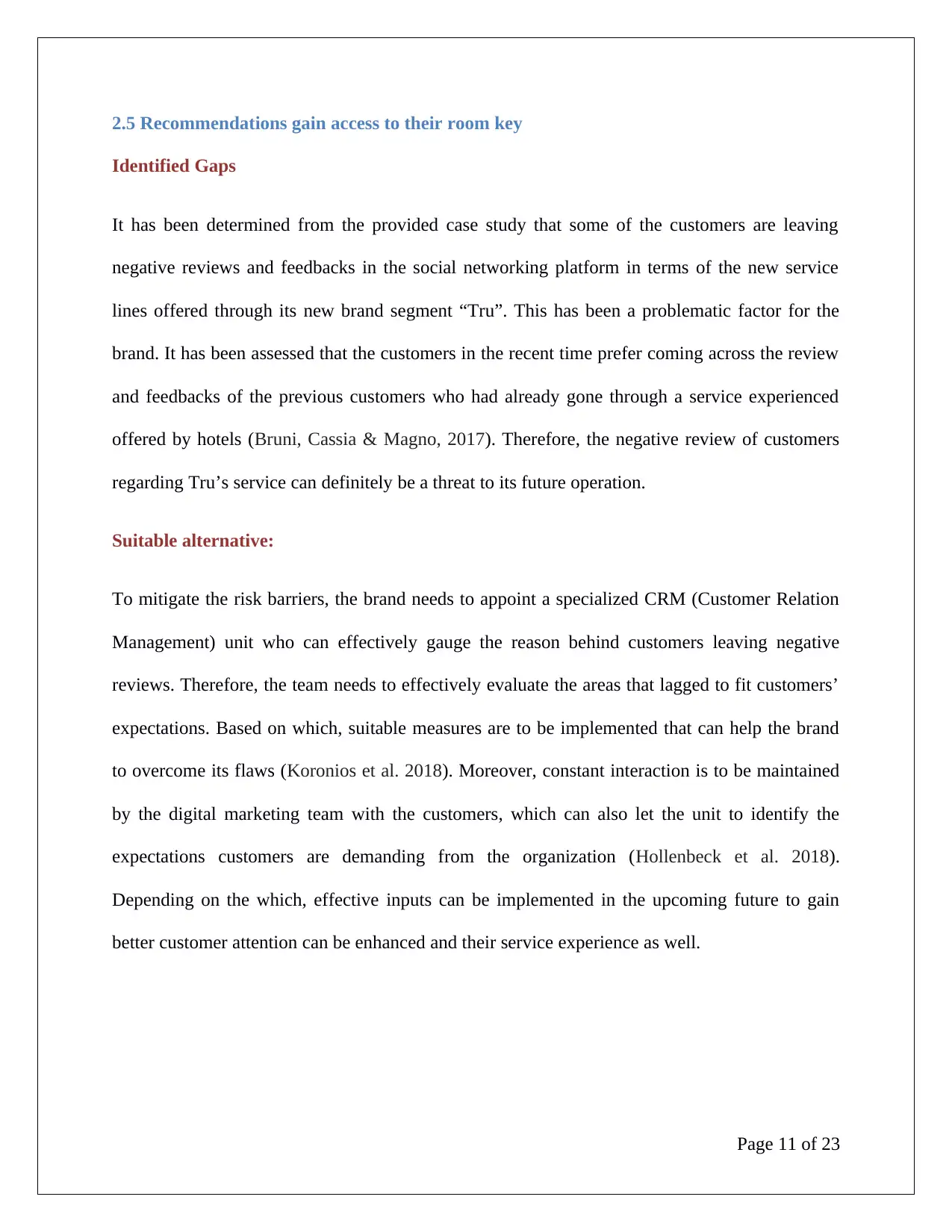
2.5 Recommendations gain access to their room key
Identified Gaps
It has been determined from the provided case study that some of the customers are leaving
negative reviews and feedbacks in the social networking platform in terms of the new service
lines offered through its new brand segment “Tru”. This has been a problematic factor for the
brand. It has been assessed that the customers in the recent time prefer coming across the review
and feedbacks of the previous customers who had already gone through a service experienced
offered by hotels (Bruni, Cassia & Magno, 2017). Therefore, the negative review of customers
regarding Tru’s service can definitely be a threat to its future operation.
Suitable alternative:
To mitigate the risk barriers, the brand needs to appoint a specialized CRM (Customer Relation
Management) unit who can effectively gauge the reason behind customers leaving negative
reviews. Therefore, the team needs to effectively evaluate the areas that lagged to fit customers’
expectations. Based on which, suitable measures are to be implemented that can help the brand
to overcome its flaws (Koronios et al. 2018). Moreover, constant interaction is to be maintained
by the digital marketing team with the customers, which can also let the unit to identify the
expectations customers are demanding from the organization (Hollenbeck et al. 2018).
Depending on the which, effective inputs can be implemented in the upcoming future to gain
better customer attention can be enhanced and their service experience as well.
Page 11 of 23
Identified Gaps
It has been determined from the provided case study that some of the customers are leaving
negative reviews and feedbacks in the social networking platform in terms of the new service
lines offered through its new brand segment “Tru”. This has been a problematic factor for the
brand. It has been assessed that the customers in the recent time prefer coming across the review
and feedbacks of the previous customers who had already gone through a service experienced
offered by hotels (Bruni, Cassia & Magno, 2017). Therefore, the negative review of customers
regarding Tru’s service can definitely be a threat to its future operation.
Suitable alternative:
To mitigate the risk barriers, the brand needs to appoint a specialized CRM (Customer Relation
Management) unit who can effectively gauge the reason behind customers leaving negative
reviews. Therefore, the team needs to effectively evaluate the areas that lagged to fit customers’
expectations. Based on which, suitable measures are to be implemented that can help the brand
to overcome its flaws (Koronios et al. 2018). Moreover, constant interaction is to be maintained
by the digital marketing team with the customers, which can also let the unit to identify the
expectations customers are demanding from the organization (Hollenbeck et al. 2018).
Depending on the which, effective inputs can be implemented in the upcoming future to gain
better customer attention can be enhanced and their service experience as well.
Page 11 of 23
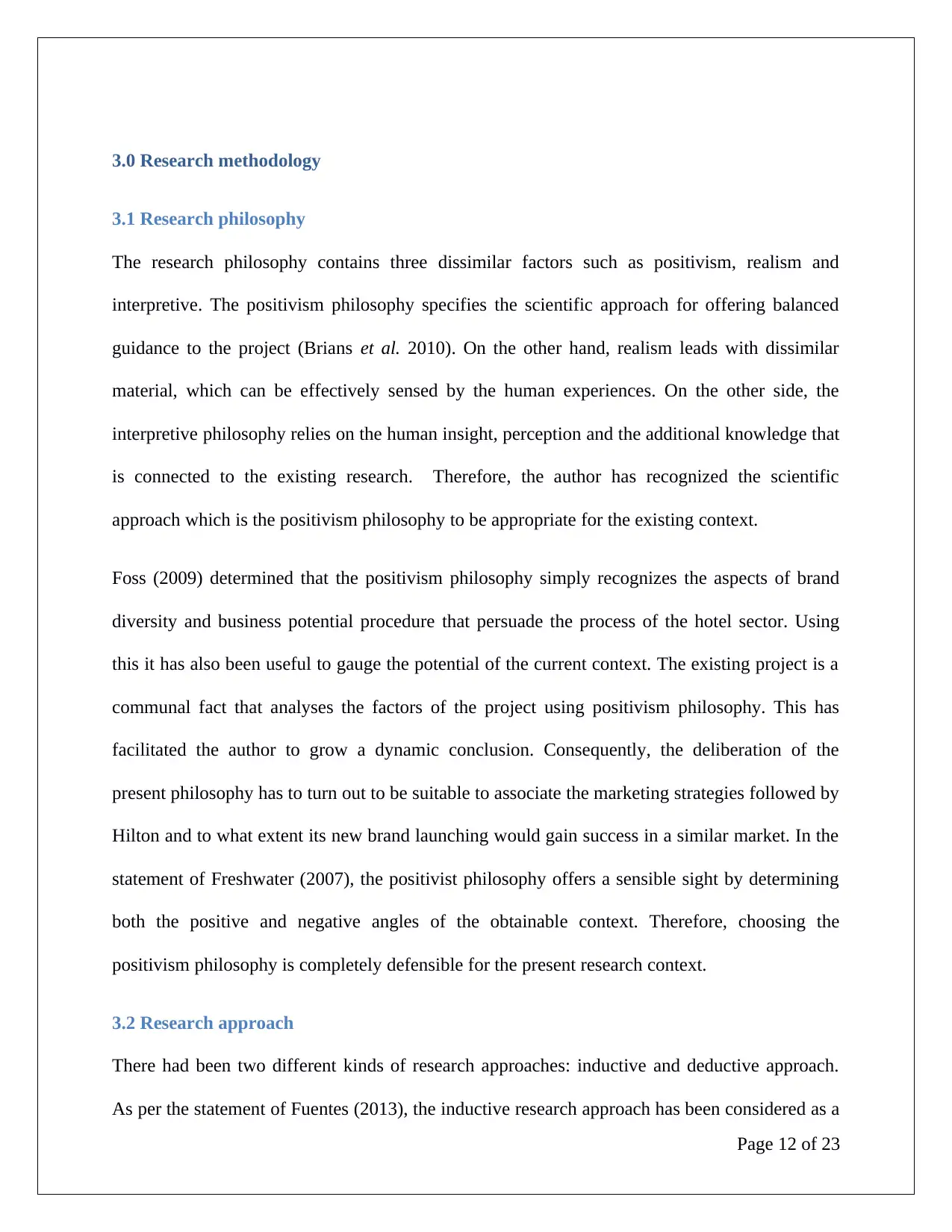
3.0 Research methodology
3.1 Research philosophy
The research philosophy contains three dissimilar factors such as positivism, realism and
interpretive. The positivism philosophy specifies the scientific approach for offering balanced
guidance to the project (Brians et al. 2010). On the other hand, realism leads with dissimilar
material, which can be effectively sensed by the human experiences. On the other side, the
interpretive philosophy relies on the human insight, perception and the additional knowledge that
is connected to the existing research. Therefore, the author has recognized the scientific
approach which is the positivism philosophy to be appropriate for the existing context.
Foss (2009) determined that the positivism philosophy simply recognizes the aspects of brand
diversity and business potential procedure that persuade the process of the hotel sector. Using
this it has also been useful to gauge the potential of the current context. The existing project is a
communal fact that analyses the factors of the project using positivism philosophy. This has
facilitated the author to grow a dynamic conclusion. Consequently, the deliberation of the
present philosophy has to turn out to be suitable to associate the marketing strategies followed by
Hilton and to what extent its new brand launching would gain success in a similar market. In the
statement of Freshwater (2007), the positivist philosophy offers a sensible sight by determining
both the positive and negative angles of the obtainable context. Therefore, choosing the
positivism philosophy is completely defensible for the present research context.
3.2 Research approach
There had been two different kinds of research approaches: inductive and deductive approach.
As per the statement of Fuentes (2013), the inductive research approach has been considered as a
Page 12 of 23
3.1 Research philosophy
The research philosophy contains three dissimilar factors such as positivism, realism and
interpretive. The positivism philosophy specifies the scientific approach for offering balanced
guidance to the project (Brians et al. 2010). On the other hand, realism leads with dissimilar
material, which can be effectively sensed by the human experiences. On the other side, the
interpretive philosophy relies on the human insight, perception and the additional knowledge that
is connected to the existing research. Therefore, the author has recognized the scientific
approach which is the positivism philosophy to be appropriate for the existing context.
Foss (2009) determined that the positivism philosophy simply recognizes the aspects of brand
diversity and business potential procedure that persuade the process of the hotel sector. Using
this it has also been useful to gauge the potential of the current context. The existing project is a
communal fact that analyses the factors of the project using positivism philosophy. This has
facilitated the author to grow a dynamic conclusion. Consequently, the deliberation of the
present philosophy has to turn out to be suitable to associate the marketing strategies followed by
Hilton and to what extent its new brand launching would gain success in a similar market. In the
statement of Freshwater (2007), the positivist philosophy offers a sensible sight by determining
both the positive and negative angles of the obtainable context. Therefore, choosing the
positivism philosophy is completely defensible for the present research context.
3.2 Research approach
There had been two different kinds of research approaches: inductive and deductive approach.
As per the statement of Fuentes (2013), the inductive research approach has been considered as a
Page 12 of 23
⊘ This is a preview!⊘
Do you want full access?
Subscribe today to unlock all pages.

Trusted by 1+ million students worldwide
1 out of 23
Related Documents
Your All-in-One AI-Powered Toolkit for Academic Success.
+13062052269
info@desklib.com
Available 24*7 on WhatsApp / Email
![[object Object]](/_next/static/media/star-bottom.7253800d.svg)
Unlock your academic potential
Copyright © 2020–2025 A2Z Services. All Rights Reserved. Developed and managed by ZUCOL.



